Balinese cosmology considers south the most impure direction. Yet southern Bali attracts most travellers, where the infrastructure and commercialism are most developed. Moving south from Denpasar, office-block facades give way to signs advertising hotels, tours and shops.
Throughout the island’s history, southern Bali has been the first to welcome or repel outsiders. Bali’s first king, Sri Kesari Warmadewa, conquered invaders in AD 913. In later times, important Javanese priests trod these shores. Empu Kuturan came to Bali in the 10th century and introduced the meru, or multi-tiered roofed shrine. Bali’s exposure to the West began when sailors from Dutch explorer Cornelis de Houtman’s fleet were so entranced by the island that they jumped ship to stay forever, beginning a trend that has continued to this day. The first hotel on Kuta beach was built by an American couple in 1936.
In addition to the sun, sand, sea and infrastructure (often lacking in other areas of Indonesia), visitors continue to flock to southern Bali beaches in part because of the local people’s attitudes. Although they may not always approve of foreign shenanigans, the Hindu Balinese are more prone to look the other way than Indonesians elsewhere.
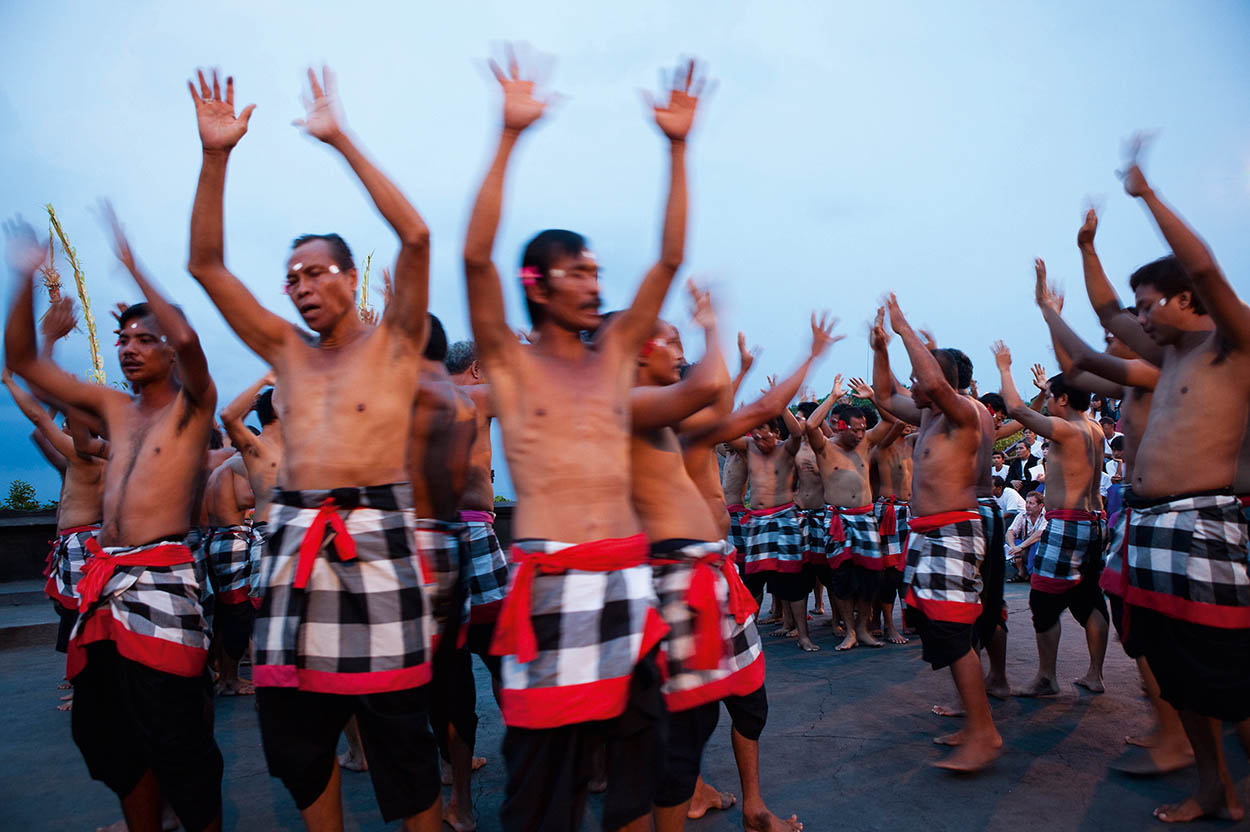
The kecak dance.
Corrie Wingate/Apa Publications
As South Bali continues on its developmental journey, the villages are taking an increasing role and are striving to create their own identities. While Kuta is happy to be backpacking, rabble-rousing nirvana, Tuban to its south has reinvented itself with five-star resorts. North of Kuta, Legian harbours those who want to be part of the Kuta scene, but prefer to sleep somewhere quieter. To the northwest, exclusivity comes in the form of beaches in Seminyak and Petitinget, or rural settings in Kerobokan and Canggu. On the opposite coast, Sanur remains its own special enclave of tourists and expats.
Further south, Jimbaran and the rugged cliffs of Bukit Badung create an entirely different atmosphere. Nusa Dua continues to draw those who seek total, luxurious escape, protected from the rest of the world, while Tanjung Benoa captivates a less staid crowd of sun- and sea sports-lovers.
In short, South Bali has something to suit every budget and taste, and it’s very happy to share its glee with the rest of the world.
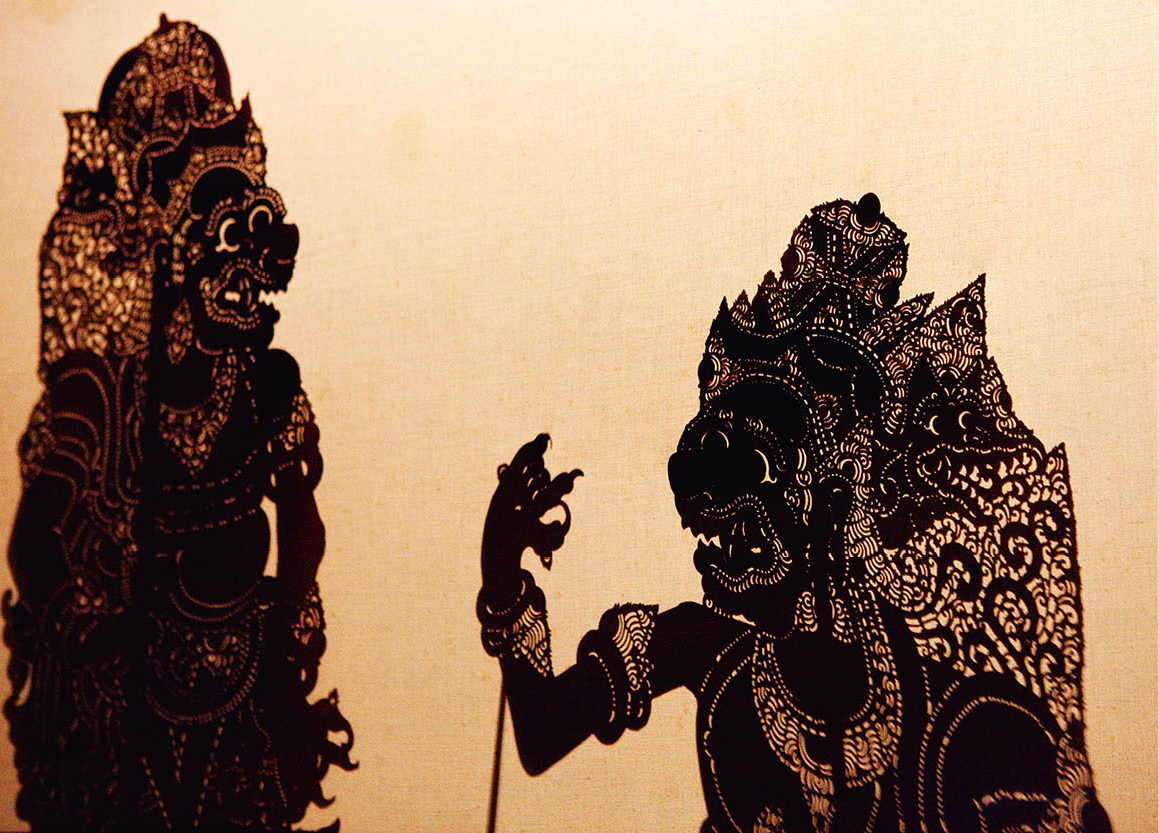
Shadow puppets.
Corrie Wingate/Apa Publications
Denpasar
Denpasar 1 [map] is a traffic-clogged government and financial centre incorporating winding alleys, illogical one-way streets and pungent smells. If your mind has been unwinding on the beach, it may well be wound back up on an excursion into Denpasar. Once a parking spot is located, most of the city’s main sights are within walking distance from each other.
Central to the city is Taman Puputan (Puputan Park), a large, grassy open space commemorating the battle between the raja of the Badung Empire and the Dutch militia in l906. Rather than being conquered by the Dutch, thousands of Balinese warriors, dressed in their finest regalia and armed only with keris daggers and spears, hurled themselves into battle in a heroic sacrifice, dying either by their own hands or by Dutch bullets in ritual suicide known as puputan (literally, ‘end’). Today, the slaughter of the estimated 600 to 2,000 is memorialised by a bronze statue. North of the square is the former Dutch governor’s residence, where the raja’s palace once stood.
Catur Mukha, the great statue with four faces and eight arms at Denpasar’s main intersection (at the northwestern corner of Taman Puputan), represents the Hindu god of the four directions.
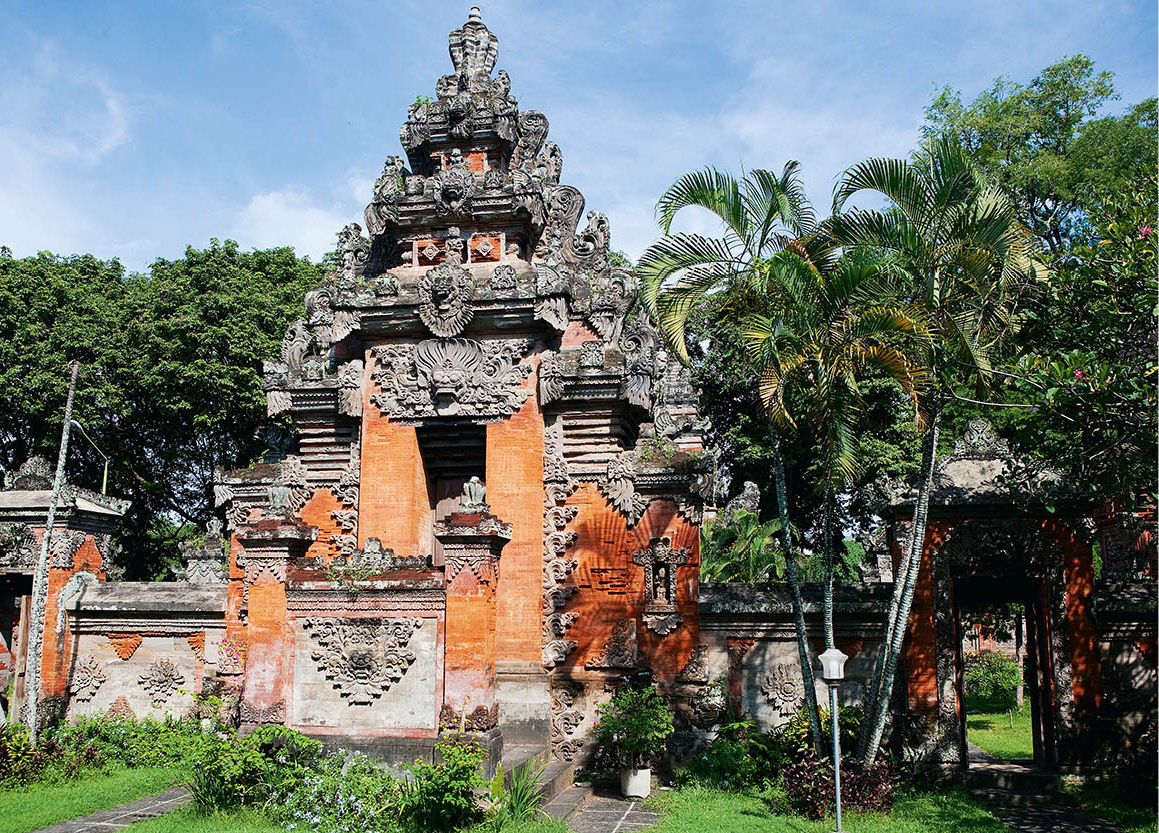
The Museum Negiri Propinsi Bali.
Corrie Wingate/Apa Publications
East of the square is Museum Negeri Propinsi Bali (Bali Museum; Mon–Thu 8am–3.30pm, Fri 8–12.30pm). Built in 1932 by the Dutch, it presents a comprehensive history of Bali’s social and cultural development from prehistoric times to the early 20th century. Items are well presented, although no specific dates of origin are given, but knowledgeable English-speaking guides are on hand. The museum is notable for its fine architecture, combining the two principal edifices of Balinese temples (pura) and palaces (puri): split gate with outer and inner courtyards, and the kulkul (wooden signal drum) tower.
Fact
The name Walter Spies crops up repeatedly in books on Balinese art. The shy German artist who settled in Campuhan, Ubud, in 1927, together with Dutch artist Rudolf Bonnet, had a profound effect on the development of Balinese painting.
The museum is representative of the entire island. The main building, with its wide-pillared verandah, resembles the Karangasem palaces of East Bali, with a porch used by officials in audience with the raja. The windowless building to its north reflects the Tabanan palace style of West Bali. The brick building, Gedung Buleleng, belongs to the northern palace style of Singaraja; inside are beautiful examples of wedding costumes and items used in religious rituals.
Next to the museum is the modern state temple, Pura Jagatnata, dedicated to Sanghyang Widi Wasa, the supreme god (manifested in Bali’s numerous local deities and ancestral spirits). Elaborate ceremonies are held here every full and new moon. The tall padmasana (lotus throne), made of white coral, symbolises universal order. The turtle Bedawang Nala and two naga serpents represent the foundations of the world, while the throne signifies the cosmic mountain.
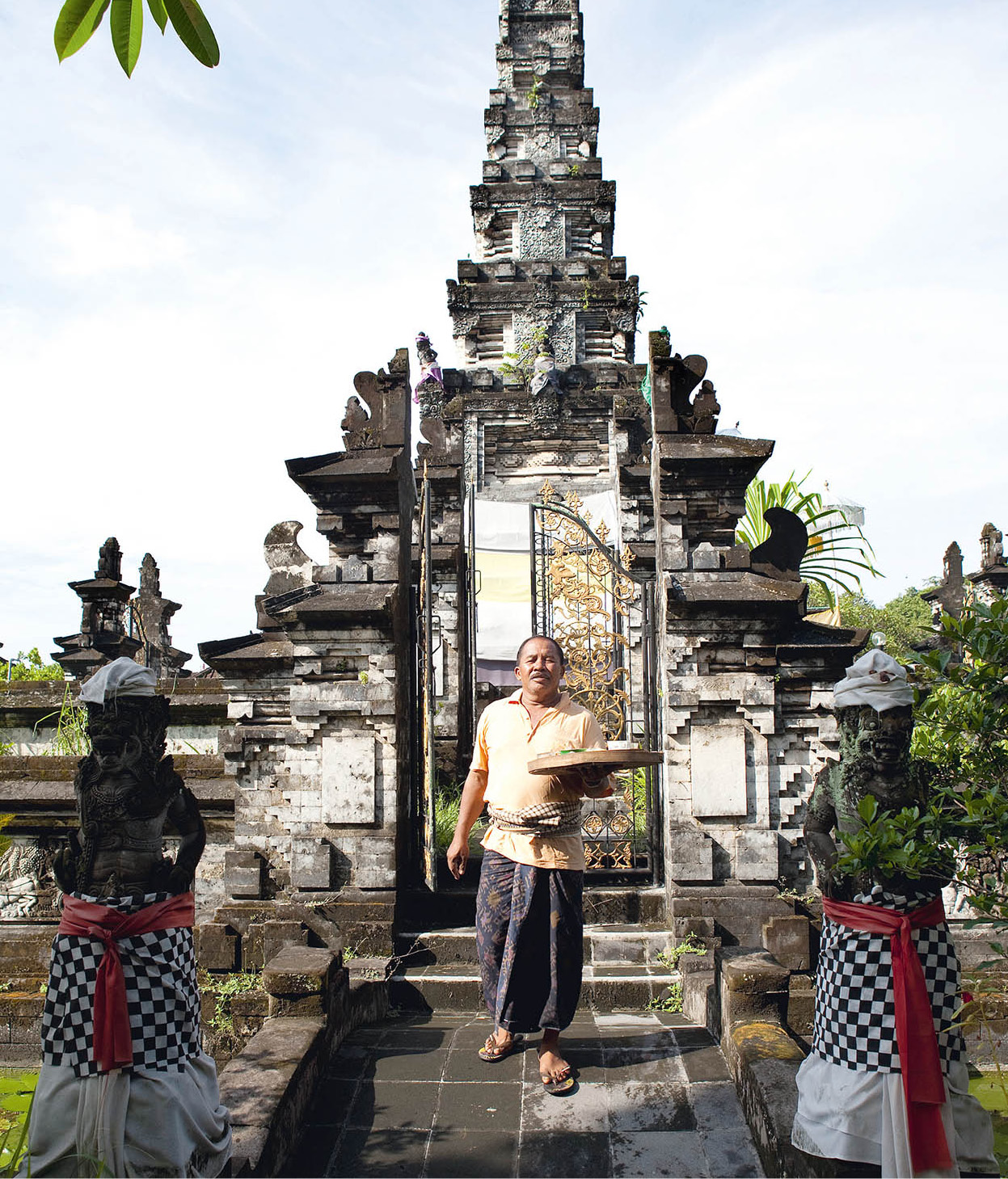
A shrine at Pura Jagatnata, Denpasar.
Corrie Wingate/Apa Publications
Denpasar means ‘north of the market’. Pasar Badung (daily 24 hours), on Jalan Gajah Mada is a four-storey building housing Bali’s largest traditional market. Locals shop for fruit and vegetables, meat and seafood, clothing, spices, baskets, ritual paraphernalia and everything else. Women wait outside offering market tours for a negotiable fee, with stops at shops where they earn a commission. Politely decline their assistance and stroll on your own. Across the Tukad Badung canal is Pasar Kumbasari (daily 8am–5pm), offering the same items as Pasar Badung plus handicrafts and art.
Nightlife in Denpasar revolves around the three huge colourful pasar malam (local night markets) that operate at Pasar Kumbasari; Pasar Kereneng, near the bus station off Jalan Kamboja; and the Pekambingan (Goat Penis) area just off Jalan Diponegoro. Here, an array of temporary stalls offer all kinds of cooked food, while hawkers push more unusual items like snake oil and charms as well as the ubiquitous T-shirts and sandals.
Pura Maospahit (daily during daylight hours; donation), on Jalan Sutomo, is the oldest temple in the city. It dates from the 14th century, when Majapahit Empire emissaries arrived from Java. Extensive earthquake damage in 1917 resulted in much of the temple being rebuilt; the section at the back is the only part that has remained unaltered for 600 years.
Denpasar’s arts
A permanent exhibition of traditional and contemporary Balinese visual arts is at the Taman Werdi Budaya (popularly called the Art Centre; daily 8am–3.30pm), 2km (1.25 miles) east of downtown, on Jalan Nusa Indah. Bali’s numerous art disciplines are represented at this large complex, including painting, woodcarving, shadow puppetry, silverwork, weaving, dance costumes and even ivory carving. Works by Bali’s foreign artists are displayed in the museum.
The Art Centre was established in 1973 to showcase Balinese art and culture and includes teaching facilities, a restaurant, craft shop and an outdoor arena for traditional dances. The grounds are also home to the annual Bali Art Festival (mid-June–mid-July).
Next to the centre is Sekolah Tinggi Seni Indonesia (STSI; Mon–Fri 8am–2pm), the Indonesia Institute of the Arts, founded in 1967. Students study traditional dance, music and puppetry, and classical and contemporary choreography.
For serious study, the Pusat Dokumentasi (Documentation Centre) in Renon offers a collection of works in all languages on Balinese life and culture. Documents may not be removed, but can be photocopied on the premises. A lovely tree-lined ‘suburb’ southeast of Denpasar, Renon is also the location of most foreign consulates and the respected Udayana University.
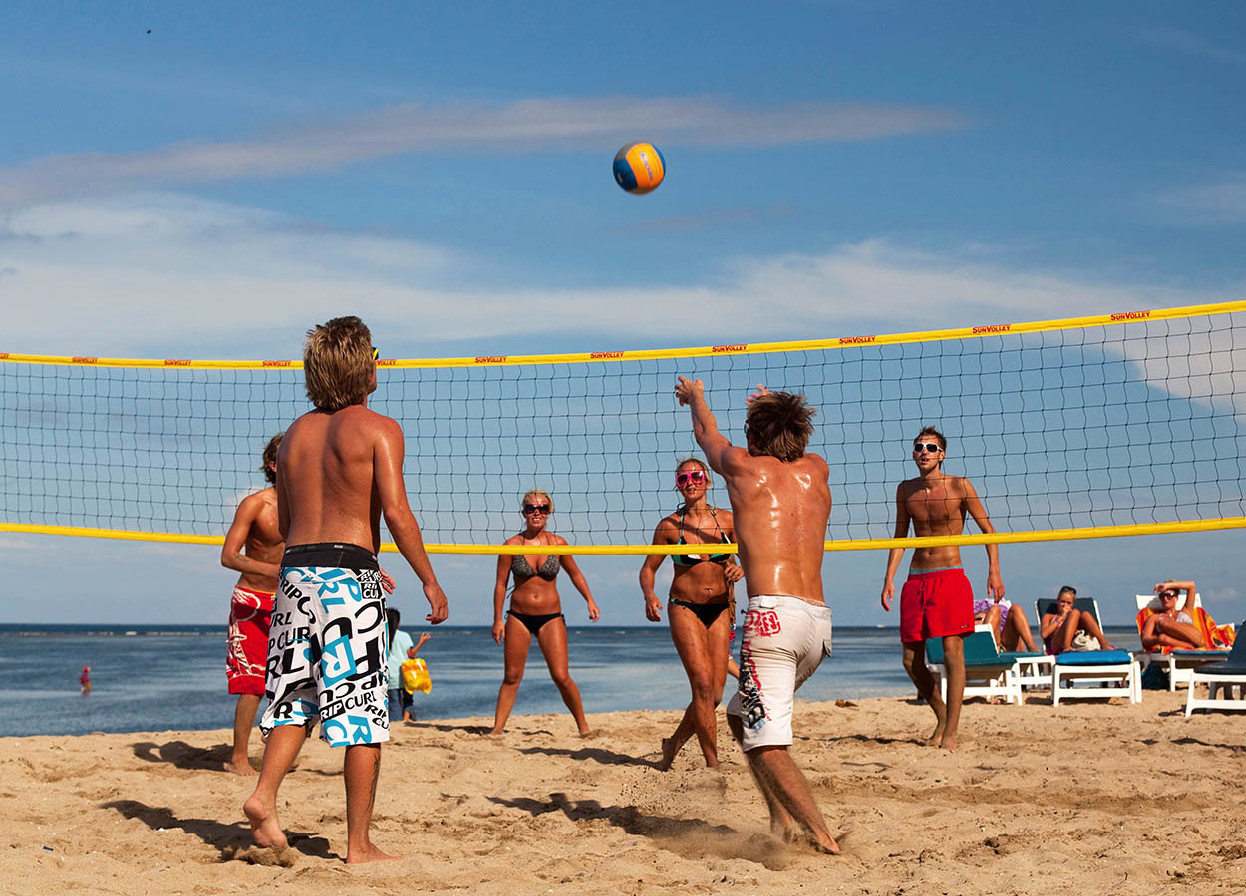
Beach volleyball at Sanur.
Corrie Wingate/Apa Publications
Local tradition maintained that shipwrecks held bounty from Baruna, god of the sea, and thus anyone had rights to them. The Dutch had a different viewpoint. In 1904, a Chinese schooner was wrecked off the shores of Sanur 2 [map]. Pillaging by the local people breached a treaty between the Balinese and the Dutch, and this incident was just the excuse the Dutch needed to wage war against the Badung raja. The result was the puputan commemorated in Denpasar’s Taman Puputan. Only one person, a child, survived the massacre.
Sanur became an enclave for artists around the world in the 1930s. By the 1950s, the first cluster of bungalows in Sanur was built, attracting international travellers. The Bali Beach Hotel opened in l966, built with Japanese reparation money after World War II. When the 10-storey hotel first opened, it was a source of wonder to the Balinese with its running water, electricity and elevators. Bali’s only high-rise structure at the time, and something of an eyesore, it was gutted by a mysterious fire in 1992 but was rebuilt and reopened less than one year later as the Inna Grand Bali Beach Hotel (Jln. Hang Tuah, Samur; tel: 036-1288 511; www.grandinnabalibeach.com).
Today, Sanur beach has all levels of accommodation, with access roads lined with shops and restaurants. Amid the development and tourism frenzy, Sanur has managed, remarkably, to retain much of its quaint heritage as a Brahman-dominated village, where trance performances are still staged during local temple festivals. Sanur’s seas are calm and shallow, disappearing altogether at low tide, leaving little more than great swathes of sandy mud and coral stretching for hundreds of metres out along the reef. When the tides are high, however, Sanur offers windsurfing and sailing.
One of the few historical sites in Sanur is the home of Belgian painter Jean Le Mayeur de Mepres. He moved to Bali in l932, where he lived until his death in 1958. Museum Le Mayeur (Sun–Thu 8am–3pm, Fri 8am–1pm), just north of Inna Grand Bali Beach Hotel, has gardens full of statues, luxuriant gold-and-crimson carvings, and Le Mayeur’s own paintings, mostly of his late wife, Ni Polok, a renowned legong dancer.
At the southern end of Sanur is the Pura Belanjong (daily during daylight hours; donation), notable for the island’s oldest example of writing, the Prasasti Belanjong, an inscribed pillar dating from AD 913 and discovered in the early 1930s. The 177cm (70in) tall stone column is not much to look at, but close inspection reveals two forms of writing, ancient Balinese and Sanskrit.
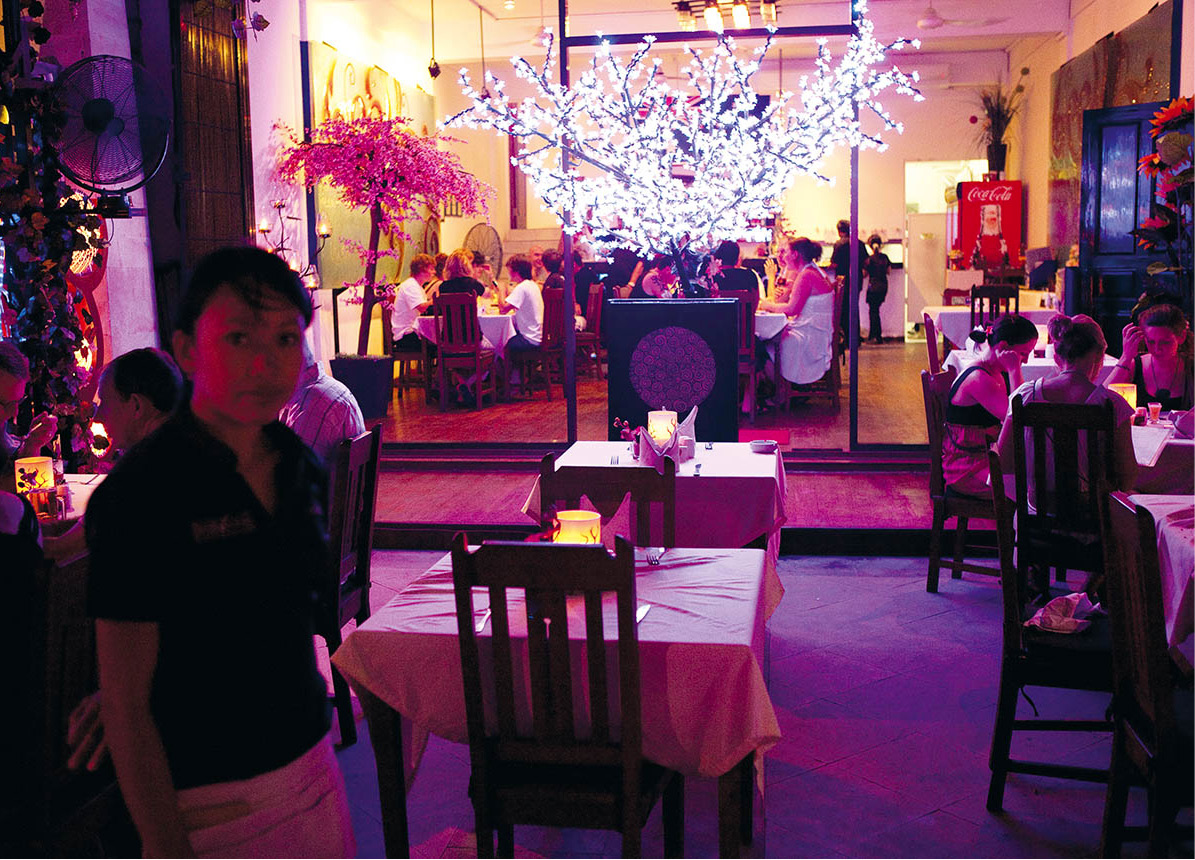
Eating out, Seminyak.
Corrie Wingate/Apa Publications
Kuta, Tuban and Legian
In former times Kuta 3 [map] was a leper colony and slave station with poor soil; its original villagers were farmers, fishermen and metalsmiths. At the genesis of mass tourism, they looked askance at foreigners frolicking along the ocean, the Balinese idea of the underworld. But they soon saw there were profits to be made and invited travellers into their homes for clean, simple and cheap accommodation.
For many, Kuta is Bali, while others decry its plunge into rampant commercialism. As long as the pleasure seekers are happy and villagers continue to leave canang – little offering trays – at the high-tide mark each day to pacify the spirits, Kuta beach seems to embrace both worlds. Both Balinese and foreigners are found along its golden sands surfing, sunbathing, strutting and selling. Kuta’s surf break is among the best for learners, but the undertow is fierce, so be sure to swim in places marked by flags. The sunset here is usually glorious.
Fact
Danish trader Mads Lange came to Kuta in 1839 and soon monopolised commodity trading and currency exchange. He died two decades later, perhaps of poisoning. He is buried in a Kuta cemetery, where his home and palm oil factory once stood.
Inland from the beach, Kuta is packed with a dazzling array of pubs, bars, souvenir shops, tattoo parlours, travel offices, accommodation and handicrafts kiosks frequented by the young at heart. Nestled in between are temples, somehow retaining their dignity. Beach and street hawkers remain an annoyance, and this once-peaceful village is now punctuated by drugs, prostitution and muggings; don’t get too starry-eyed on the dark beach at night. South of Kuta, down Jalan Dewi Sartika, quieter Tuban village is an upmarket resort area. Waterbom Park (daily 9am–6pm) has water slides, restaurants and spa treatments. There are lifeguards on duty, but adults must accompany children under 12 years old. It can get crowded later in the day and especially at weekends with long queues, but is well worth the wait.
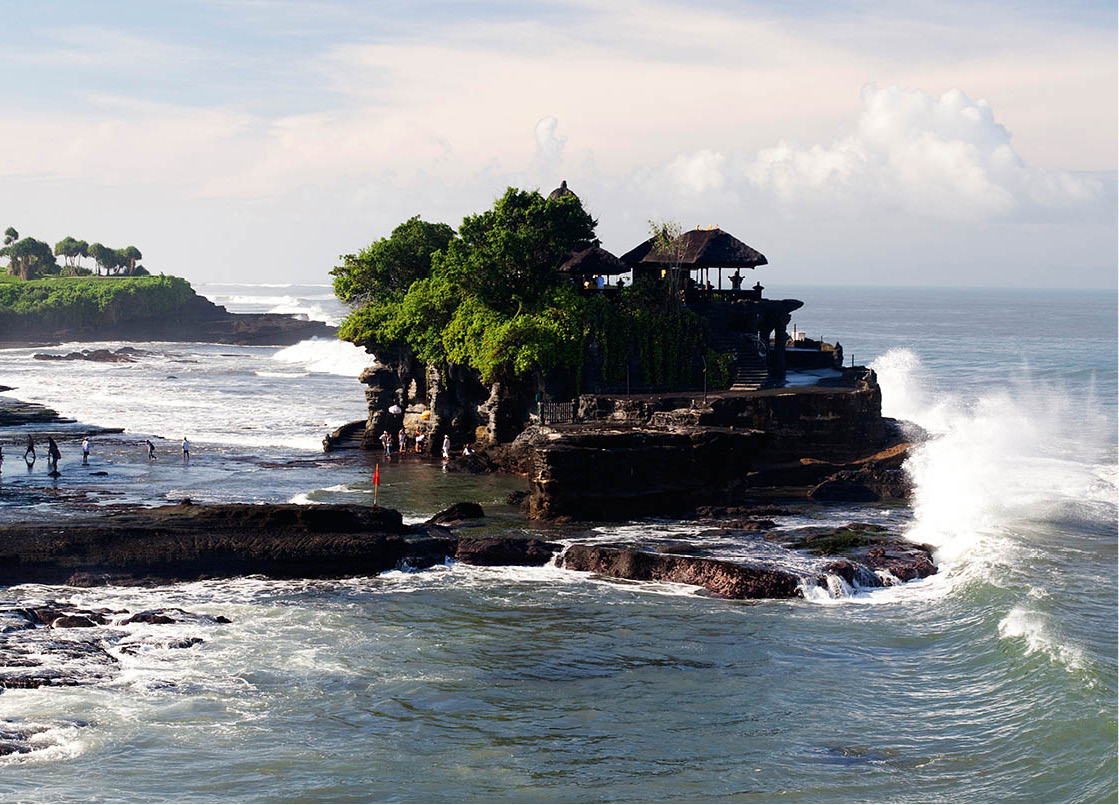
Pura Tanah Lot.
Corrie Wingate/Apa Publications
Just opposite Waterbom Park and next to Discovery Kartika Plaza Hotel is the modern Discovery Shopping Mall – right on the beach – with an array of shops and the Centro and Sogo department stores.
In memory of the victims of the 2002 Bali bombings, a permanent memorial was built on the site of the destroyed Paddy’s Pub on Legian Street. The memorial is made of intricately carved stone, set with a large marble plaque, with names and nationalities of each of those killed, and is illuminated at night. A new bar, ‘Paddy’s Reloaded’, was reopened further along Legian Street.
Legian 4 [map] is more sedate than Kuta and is preferred by Bali’s young expatriate population. Their influence can be seen throughout the village in boutiques and a number of excellent restaurants, cafés and bars.
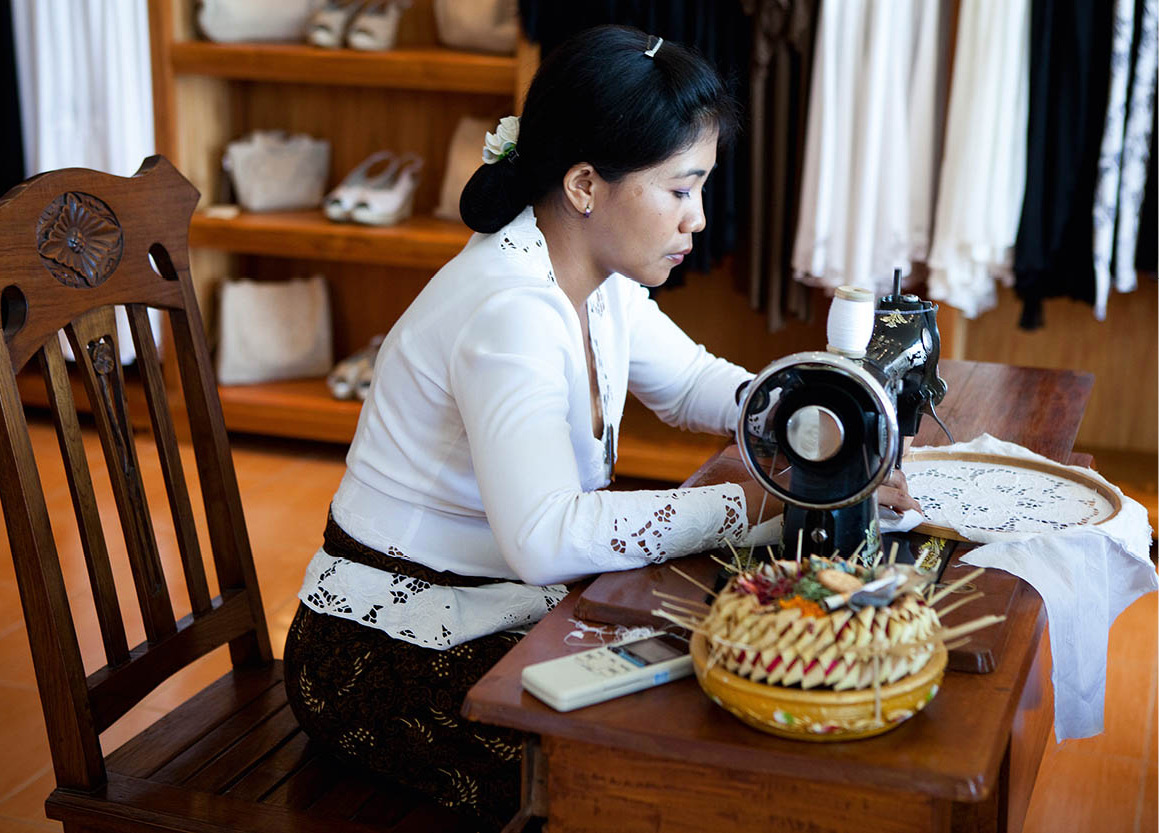
Uluwatu lace shop, Seminyak.
Corrie Wingate/Apa Publications
Seminyak, Kerobokan, Petitenget and Canggu
Further north, the decidedly hip Seminyak is home to exclusive hotels, designer boutiques, spas, trendy beachside restaurants and nightclubs, which are crammed into every available space. This is expat heaven, and expensive private and rental villas have replaced much of what once was the village.
Seminyak has the same wide sandy beach and thundering surf as Kuta, but without the heaving crowds. Jalan Kayu Aya at its northern boundary and Jalan Abimanyu at its southern end have also made a name for themselves: the former has a clutch of hip restaurants and the latter some equally trendy bars and clubs.
Northeast of Seminyak is Kerobokan, which is doing its best to get into the tourism game. Without a beach to lure travellers, it bills itself as a rural getaway, with rental villas the key draw. Along Jalan Raya Kerobokan are furniture shops and galleries catering to exporters.
Northwest of Seminyak is Petitenget. Formerly known to tourists only as a part of Seminyak (the dividing line is the north side of Jalan Kayu Aya), it is now establishing its own identity as upmarket, like its neighbour, but removed from the horrendous traffic further south. This condition may be short-lived, however, as new resorts, more villas, and expensive restaurants are popping up everywhere.
Continuing northwest towards Tanah Lot, the coastline is an enormous construction zone. This is Canggu, once only known to surfers, but now being taken over by foreigners whose villas can more aptly be described as mansions. The village atmosphere they enjoy now will soon become another Seminyak.
Continuing northwest from Canggu will bring you to one of Bali’s most noted sites, Pura Tanah Lot 5 [map] (daily, daylight hours). From the Kerobokan junction, turn west towards Canggu and follow the signs.
Set apart from the land on a stone pedestal carved by incoming tides, Tanah Lot’s solitary black towers and tufts of foliage spilling over the cliffs recall the delicacy of a Chinese painting, although the gauntlet of souvenir stalls and hawkers on the temple approach may diminish this image. In caves surrounding the temple dwell striped sacred snakes, discreetly left undisturbed by Balinese. Only worshippers are allowed inside the temple, but visitors get a dramatic view from the adjacent hill, especially at sunset.
Tip
There are venomous sea snakes living in the caves and rocks surrounding Pura Tanah Lot – said to be guarding the temple against intruders – so be careful if you cross over. Most people are content with the view from across the beach.
Tanah Lot is attributed to the 16th-century priest Danghyang Nirartha. During his travels, Nirartha saw a bright light emanating from a point on the west coast and came to this spot to meditate. The disciple of a local spiritual leader became fascinated by Nirartha and began to study with him. This angered the local priest who, filled with jealousy, challenged Nirartha. The unflappable Nirartha simply moved his meditation spot into the ocean, and this point became known as Tanah Lot, or ‘Land in the Sea.
An exclusive resort area is found along the coast south of Jimbaran 6 [map], housing hotel bigwigs such as Four Seasons and InterContinental. All of them face the sea within easy reach of Jimbaran village and its justly celebrated beachside seafood restaurants.
Connected to the mainland by a low, narrow isthmus, the limestone tableland at Bukit Badung, a peninsula rising to 200 metres (660ft) above sea level, is a striking contrast to the lush Bali mainland. Vantage spots along the road that crosses the hill afford breathtaking northern vistas rising to the peaks of distant volcanoes; an ideal place to catch beautiful sunsets. The ultra luxurious Bvlgari Resort – from the Italian jeweller of that name – is nestled between the cliff and the ocean near Uluwatu.
At the western tip of Bukit Badung, where rocky precipices drop almost 100 metres (330ft) to the ocean, is Pura Luhur Uluwatu 7 [map] (daily, daylight hours), 70 metres (230ft) up on a dramatic promontory. Originally dating from around the 16th century, it is one of the Sad Kahyangan, or Six Temples of the World, revered by all Balinese. The holy Javanese priest Danghyang Nirartha established this temple, and it is said he achieved enlightenment here. The innermost sanctuary, jeroan, is off-limits to non-worshippers but can be viewed from the side. South of the temple and car park, a panoramic short path leads along the cliff top.
The area just north of the temple is well known among surfers. Only experienced riders should attempt the dangerous reefs, strong currents and tricky waves from April to September. Viewers can watch the action from the shore, but the sea here is not ideal for swimming.
The cremation ceremony
Balinese Hindus believe a soul borrows a physical human body, so upon death this body is returned to the five elements – wind, earth, fire, water and ether – to release the soul and enable it to reincarnate on earth or unite with the divine Supreme Being. No weeping or grief is openly displayed, as this makes the soul unwilling to leave.
Cremation ceremonies are so costly that a family often waits years to share expenses in a joint ceremony. In the meantime, the body is purified and buried in the village cemetery. Once a cremation date is set, ritual specialists, priests, friends and neighbours help mobilise the communal spirit. If a body has been buried, the bones are exhumed or the body is placed in a sarcophagus inside a colourful cremation tower.
A noisy procession leads the way as dozens of men carry the tower on their shoulders to a field where the cremation will take place, spinning it at crossroads to confuse the soul so that it cannot find its way home to disturb the living.
After the corpse is reduced to ashes, the family gathers and pulverises the charred bone fragments, and puts them in a yellow coconut that they cast into the sea. Purification ceremonies for the community who participated in the cremation are held three days later.
Nusa Dua and Tanjung Benoa
Nusa Dua 8 [map], on the east coast of Bukit Badung, is a slightly sterile paradise in a ribbon-wrapped package. A purpose-built, luxury hotel enclave, sprawling in the middle of a coconut grove and alongside a white-sand beach, Nusa Dua caters decidedly to the upmarket traveller. In many ways, Nusa Dua is thin on local ambience, having been built on unused land in a concerted government effort to prevent tourism from affecting the island’s cultural sanctity. Luxury hotels wrap around the beach, among which are several international chains. Water sports available here include spectacular parasailing, and jet-skiing. The well-regarded Bali Golf & Country Club has a championship golf course, with nine holes heading towards the sea and nine holes inland. At least seven temples are within Nusa Dua’s bounds.
For many years, Tanjung Benoa 9 [map], a fishing village north of Nusa Dua on a long peninsula, was overlooked by hotel developers blinded by the obvious potential of Sanur, Kuta and Nusa Dua. The peninsula is now lined with four- and five-star hotels, as well as lower-end accommodation and restaurants. Benoa offers an attractive stretch of white-sand beach, which, like Sanur, is susceptible to the tides. A walk north up the peninsula reveals a bustling morning market and a multicultural community, evolved from decades as a trading centre, reflected in Chinese and Muslim cemeteries, and Chinese, Muslim and Hindu temples.